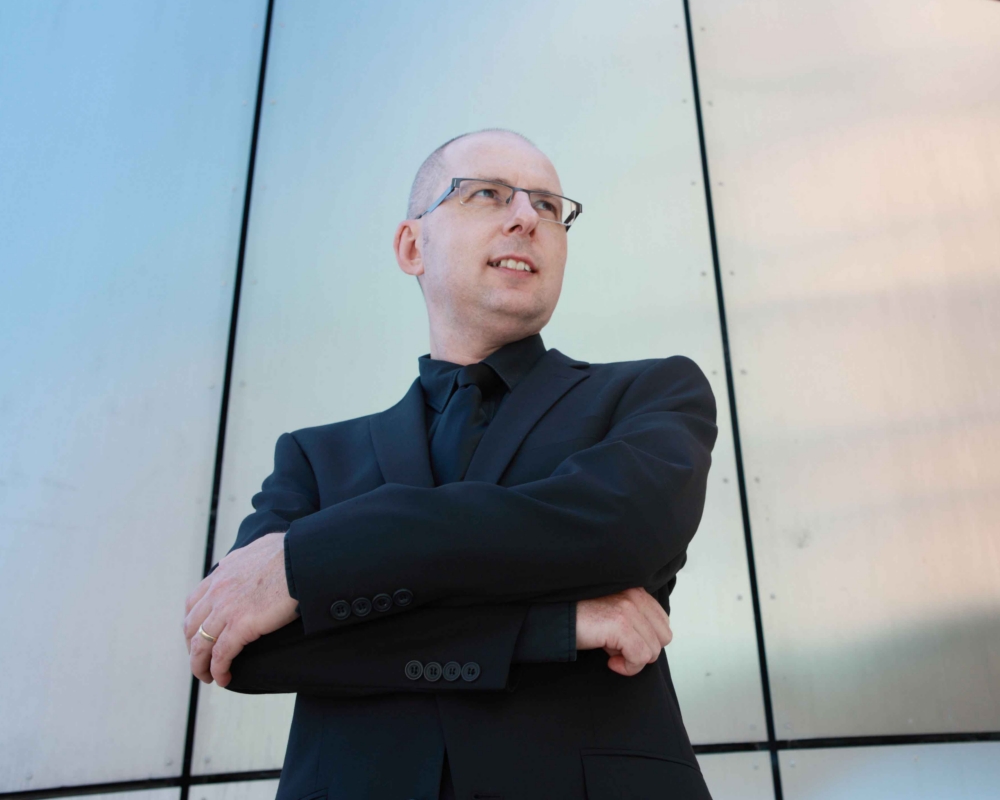MCO’s Souvenir de Florence can be heard in Melbourne on Sunday 20 September at Melbourne Recital Centre. Learn More.
Paul Stanhope
Nephesh for string octet*
In composing a work for eight string instruments, I have opted to explore various notions of duality. This is seen most obviously in the splitting of an octet into two traditional string quartets. However other quartets and duos are possible, such as the quartet of violas and cellos heard in the beginning of the piece. The piece is also split into two movements, outlining a classic Cartesian dualism of soul and body entitled here Prayer and Dance.
Unlike the disembodied mathematical music imagined by Plato and Pythagoras – philosophical predecessors of Descartes – I imagine this prayer as a physical act, full of sobbing laments, pleas and cries of exaltation. The material for the opening utterances of this movement is derived from Sephardic Chant: that is Jewish liturgical music from a Babylonian tradition. This ancient, beautiful song is heard first in the cello with echoes from the violas. A series of rhapsodic interludes are constructed between utterances of the chant. At times soft and sombre, the music builds into a lather before dissolving once more into more gentle chanting phrases.
The second movement – Dance – is built around jaunty leaps and ping-pong like exchanges of material from one quartet to another. The material first heard as pizzicatos at the beginning is drawn from a selection of pitches from the chant in the first movement (E, G#, G, A) with the addition of a minor seventh and tritone (D, and B flat). The material is transformed into blues-inflected riffs, ostinatos and numerically-based rhythmic patterns, tossed between the two quartets in a more overt way than in the first movement. After a series of episodes, including a section based around the percussive sounds of the strings, a darker reverie slowly builds toward a feverishly exuberant climax, returning the material back to the original tonal centre of E.
The title “Nephesh” is an ancient Hebrew liturgical word used to denote not only the soul, but also the whole of the self, including the body. Much older than Cartesian duality, this concept unifies ideas of body and soul as a single entity.
© Paul Stanhope 2015
Max Bruch
Concerto for Octet
I. Allegro moderato
II. Adagio
III. Allegro molto
Max Bruch (1838-1920), in addition to being a prolific German composer of symphonic, choral and chamber music, was an acclaimed conductor and teacher. While most of his working life was spent in Germany he had three seasons, from 1880 to 1883, as the conductor of the Liverpool Philharmonic Society. The Violin Concerto no. 1 in E minor Op. 26, the Scottish Fantasy for violin and orchestra Op. 46, and Kol Nidre for cello and orchestra Op. 47 remain in the concert repertoire. During his life he was renowned as a composer of large scale choral music such as Odysseus, Frithjof and Das Lied von der Glocke.
The String Octet was composed in early 1920 and was one of the last works completed by the composer. It was a reworking of a recently completed string quintet. Initially modelled on the Mendelssohn String Octet, Bruch scored his work for four violins, two violas, cello and double bass, enabling it to be included in the string orchestra repertoire as a Concerto for String Orchestra.
The opening Allegro moderato is in sonata form with sonorous contrast between the two main themes – the tranquility of the opening theme against the assertiveness of the second. The slow movement is in three sections. The first of these is autumnal in character and in contrast to the middle section marked Andante con molto di moto. A return to the opening concludes the movement. The final movement, Allegro molto, is dominated by changing moods and the perpetual motion reminiscent of Mendelssohn.
Pyotr Il’yich Tchaikovsky
String Sextet in D minor Op. 70 Souvenir de Florence
I. Allegro con spirito
II. Adagio cantabile e con moto
III. Allegretto corto moderato
IV. Allegro con brio e vivace
The Russian composer Pyotr Il’yich Tchaikovsky (1840-1893) was, according to theorist Boris Asaf′yev, the first composer of a new Russian type: fully professional, who firmly assimilated traditions of Western European symphonic mastery. In a deeply original, personal and national style he united the symphonic thought of Beethoven and Schumann with the work of Glinka.
Souvenir de Florence Op. 70 was composed in 1890 as a string sextet. The work was scored for two violins, two violas and two cellos. Following the first performance in November 1890, Tchaikovsky made revisions in the following year. In 1890 the composer spent time in Florence where his ballet The Sleeping Beauty was given its first performance. While in Florence he was working on a draft of his opera The Queen of Spades which was produced later that year in St. Petersburg. The year ended with the significant rupture in his relationship with his patron Nadezhda von Meck.
The work was written following Tchaikovsky’s return to Russia from Italy. The first movement in D minor is in a sonata rondo form with great contrast between the main themes. The song-like slow movement in D major is in a simple ternary form. The third movement moves to the key of A minor while the last movement returns to D minor. The final two movements are characterised by the use of folk-like melodies.
Tchaikovsky’s other major essay for strings are the Serenade in C Op. 48 which also follows a four movement structure.
*David Forrest 2015

